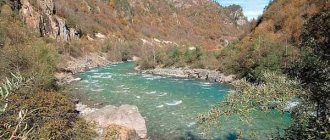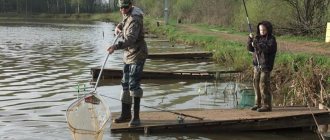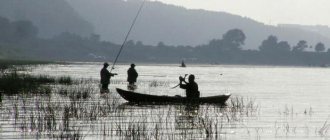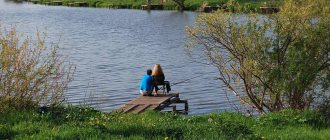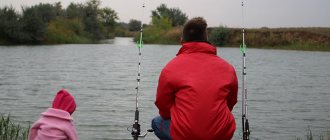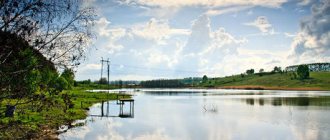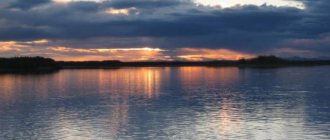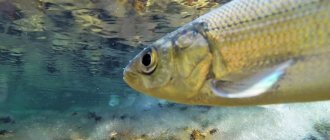Autonomous regions and territories within the federal district
• Jewish Autonomous Region, which is distinguished by a mild climate and unique natural sites, an abundance of fish in reservoirs, and the hospitality of local residents; • Chukotka Autonomous Okrug, where people ride on dog and reindeer sleds and fish all year round in rivers, lakes and the sea; • Republic of Sakha (Yakutia), where during the short summer you can relax with the whole family, and in winter get an enviable catch of fish during ice fishing; • Primorsky Krai, known for its mild climate, numerous sanatoriums, rich catches of freshwater and sea fish; • Kamchatka region, which is an excellent place for trophy salmon fishing, and is also rich in natural attractions (active and extinct volcanoes, geysers, hot mineral springs); • Khabarovsk Territory, which attracts amateur fishermen with the opportunity to catch trophy specimens of taimen weighing 40 kg, untouched nature, excellent conditions for river rafting, photo hunting, diving; • Amur region, where you can catch a number of unique species of fish that are not found anywhere else in the world; • Sakhalin region, famous for the nature reserves located there, the abundance of animals and birds that can be observed in their natural habitat, excellent fishing opportunities both in fresh water and in the sea; • Magadan region, where you can take a jeep tour along the Kolyma highway, visit active gold mines and abandoned camps, have great fishing and relax in nature.
Territories of the Far Eastern District where fishing is prohibited
Recreational fishing is prohibited on the territory of the Far Eastern Federal District:
- within the protected exclusion zones of hydraulic structures and bridges established in accordance with the legislation of the Russian Federation;
- in fishing (fishing) areas at a distance of less than 500 m from the places where stationary fishing (catch) gear, sinks, and floats are installed;
- on rice paddies;
- at the spawning grounds of Pacific salmon within the time limits determined by the commission for regulating the production (catch) of anadromous fish species.
It is prohibited to carry out recreational fishing in inland water bodies of fishery significance, with the exception of inland sea waters located on the territory of the following constituent entities of the Russian Federation.
On the territory of Primorsky Krai:
- in the tributaries of the Razdolnaya River: the Nezhinka, Ananyevka, Gryaznaya, Second River rivers from its mouth to the Nezhinka River;
- in the Yellow River;
- in the rivers Ryazanovka, Barabashevka, Vasilkovka (tributary of the Avvakumovka River);
In the territories of the Amur Region, the Jewish Autonomous Region and the Khabarovsk Territory on the border sections of the Amur River, located at a distance of 0.5 km from the mouths of the tributaries flowing into it, and deep into the Amur River along the entire width of these tributaries, as well as in the tributaries themselves within the border zone (except for amateur and sport fishing on vouchers);
On the territory of the Chukotka Autonomous Okrug - on Lake Elgygytgyn.
Fish species prohibited for fishing in the Far Eastern Federal District
It is prohibited to carry out production (catch) throughout the territory of the Far Eastern Federal District:
- all species of mammals everywhere and all year round, with the exception of fishing (catch) on permits;
- acclimatized species of aquatic biological resources not permitted for extraction (catch). Such aquatic biological resources caught in mining (catch) gear must be immediately released alive into the natural habitat with the least damage;
Harvesting (catching) of the following fish resources is prohibited.
In the Primorye subzone (within the boundaries of Primorsky Krai):
- chum salmon, salmon salmon, pink salmon, with the exception of recreational and sport fishing on vouchers;
- juvenile Pacific salmon;
- polychaete worms (polychaetes);
- Kaluga;
- Pacific herring south of Olga Bay, with the exception of recreational and sport fishing trips;
- crabs: Kamchatka crab, blue crab, spiny crab, hairy crab, opilio snow crab, with the exception of recreational and sport fishing on vouchers;
- female crabs of all kinds;
- scallop, with the exception of amateur and sport fishing on vouchers;
- Far Eastern sea cucumber, with the exception of amateur and sport fishing on vouchers;
- Pilengas, with the exception of amateur and sport fishing on vouchers;
- kelp, zostera, phyllospadix, on which Pacific herring eggs are deposited.
In the Primorye subzone (within the borders of the Khabarovsk Territory):
- crabs (Kamchatka, blue, hairy), with the exception of amateur and sport fishing on vouchers;
- Pacific salmon, with the exception of recreational and sport fishing trips;
- annual kelp;
- sturgeon (kaluga, sturgeon), as well as their juveniles;
- sea scallops (seaside), with the exception of recreational and sport fishing on vouchers;
- female crabs of all kinds.
In the North Sea of Okhotsk subzone and West Kamchatka subzone:
- Kaluga;
- Pacific salmon, with the exception of recreational and sport fishing trips;
- juvenile Pacific salmon;
- spawning smelt, with the exception of amateur and sport fishing on vouchers;
- Pacific spawning herring (with the exception of recreational and sport fishing on vouchers, as well as fishing (catching) with fishing gear (catch) and multi-hook gear with vertical hooks of the "tyrant" type without vouchers);
- female crabs of all kinds;
- kelp, zostera, phyllospadix, Lessonia laminareides, cystoseira, on which Pacific herring eggs are deposited.
In the East Kamchatka zone, West Kamchatka and Kamchatka-Kuril subzones (within the boundaries of the Kamchatka Territory):
- Pacific salmon, with the exception of recreational and sport fishing trips;
- juvenile Pacific salmon, dwarf forms of sockeye salmon and coho salmon;
- kelp, zostera, phyllospadix, on which Pacific herring eggs are deposited;
- female crabs of all kinds.
In the South Kuril and North Kuril zones, in the East Sakhalin, West Sakhalin subzones, as well as the Kamchatka-Kuril subzone within the boundaries of the Sakhalin region:
- Pacific salmon, with the exception of recreational and sport fishing trips;
- juvenile Pacific salmon;
- Far Eastern sea cucumber, with the exception of amateur and sport fishing on vouchers;
- Kaluga;
- Kamchatka crab;
- hairy quadrangular crab;
- spiny crab (only in the West Sakhalin subzone);
- female crabs of all kinds;
- sea scallops.
In the Chukchi Sea and in the Chukchi zone of the Bering Sea:
- Pacific salmon, with the exception of recreational and sport fishing trips;
- spawning smelt;
- Pacific spawning herring;
- female crabs of all kinds.
In the North Sea of Okhotsk subzone (within the boundaries of the Khabarovsk Territory):
- Kaluga;
- Pacific salmon, with the exception of recreational and sport fishing trips;
- female crabs of all kinds;
- kelp, zostera, phyllospadix, on which Pacific herring eggs are deposited.
It is prohibited to extract (catch) the following aquatic biological resources in inland waters, with the exception of inland sea waters located on the territory of the following constituent entities of the Russian Federation.
Fishing in the Primorsky Territory is prohibited:
- chum salmon, salmon salmon, pink salmon, with the exception of recreational and sport fishing on vouchers;
- juvenile Pacific salmon;
- Far Eastern soft-shelled turtle;
- middendorff pearl barley Arseniev;
- Kaluga.
Fishing is prohibited on the territory of the Amur Region, the Jewish Autonomous Region and the Khabarovsk Territory:
- grass carp;
- Schreber's Brazil;
- water chestnut chilim;
- chum salmon, pink salmon, sockeye salmon, coho salmon, with the exception of recreational and sport fishing on vouchers;
- Sims;
- sturgeon (kaluga, sturgeon), as well as their juveniles;
- middendorff pearl barley Arseniev;
- bighead carp;
- female crayfish during the period when they are with eggs;
- omul (Zeysky reservoir).
Fishing in the Magadan Region is prohibited:
- Kaluga;
- Pacific salmon, with the exception of recreational and sport fishing trips;
- juvenile Pacific salmon;
- whitefish (except for amateur and sport fishing on vouchers);
- spawning smelt.
Fishing in the Kamchatka Territory is prohibited:
- Pacific salmon, with the exception of recreational and sport fishing trips;
- juveniles of Pacific salmon, dwarf forms of sockeye salmon and coho salmon;
- kelp, zostera, phyllospadix, on which Pacific herring eggs are deposited.
Fishing on the territory of the Sakhalin region is prohibited:
- Pacific salmon, with the exception of recreational and sport fishing trips;
- juvenile Pacific salmon;
- Siberian, or ordinary, taimen;
- Manchurian minnow Lagovsky.
Fishing on the territory of the Chukotka Autonomous Okrug is prohibited:
- Pacific salmon, with the exception of recreational and sport fishing trips;
- nelma;
- Boganid paliya;
- Pilkhykai dalliya;
- Amguem dalia;
- muksuna;
- Arctic Sea omul;
- whitefish (except for amateur and sport fishing on vouchers);
- juvenile Pacific salmon;
- Beringian omul.
Important. If aquatic biological resources that are prohibited for extraction (catch) are obtained (caught), they are subject to immediate release into the natural habitat with the least damage.
Harvesting (catching) trout, palia, Pacific salmon, omul, and broad whitefish can only be carried out on the basis of permits.
Reservoirs of the Far Eastern District
Two rivers flow through the territory of the Far Eastern Federal District, which are among the largest in the world. This is Lena and Cupid. The bulk of the region's smaller rivers belong to the basins of these two main rivers. Depending on the terrain, there are both mountain and lowland rivers in the Okrug. Thanks to this, travelers can choose suitable bodies of water for leisurely boat trips, as well as kayaking and canoeing of any difficulty level. The Far Eastern Federal District has the longest sea coastline in the Russian Federation. At the same time, the Pacific section (Japanese, Okhotsk, Beringovo seas) accounts for 3.5 thousand km, and the northern seas (East Siberian, Laptev and Chukotka seas) 5.5 thousand km.
Fishing in the Far Eastern Federal District
In the north of the Far Eastern Federal District, the main objects of commercial fishing and recreational fishing are salmon and salmon-like fish. These include sedentary species (grayling, lenok, whitefish), semi-anadromous and anadromous species (chinook salmon, coho salmon, chum salmon). In search of trophy fish, fishermen go on sea fishing, which is the most productive in the Sea of Okhotsk basin, on the rivers of the mainland and island territories of the Okrug. In Vladivostok and Magadan, it is possible to rent a boat for boat trips and fishing. In a number of places you can catch squid. Fishing on the Amur is interesting because more than 160 species of fish live in the river, including more than two dozen species that are not found anywhere else in Russia. The most popular of them are the topgazer and yellowcheek. Despite the difficult weather conditions, winter fishing is also developed in the Okrug, which is carried out on the ice of rivers and lakes, as well as on frozen sea bays. Smelt, pike, and taimen are excellent for catching in winter. Organizing fishing requires knowledge of local peculiarities. To go fishing calmly and comfortably, the organization of the trip can be entrusted to a fishing and tourism company, which will select the most suitable body of water depending on the wishes of the customer, organize a transfer from the airport to the base, as well as transfer the client on site by car, boat, helicopter, pleasure boat or fishing boat sea vessel, will select interesting excursions and entertainment.
Fishing for pelengas in the Far East
> Where to fish > Fishing in Russia and around the world > Fishing for pelengas in the Far East
The homeland of the pelengas is in the Far East, where this fish can reach 3 kg, a weight and a length of 70 cm. In the 60s of the last century, the pelengas was resettled in the Azov, Black, and Caspian seas, where the pelengas not only took root, but even overtook its Far Eastern brother in size. The weight of this fish often exceeds even 8-10 kg.
This fish belongs to the family of mullet fish, the class of ray-finned fish and the species of pelengas. Mainly caught using bottom and float gear, it is a popular object for underwater hunting. Valued for its high gastronomic qualities, pelengas meat is best consumed fried, baked or stewed.
In China, the pelengas are called xu-yu, and in Japan, maenads. In the Far East, most of the pelengas live in the Peter the Great Gulf, as well as in the Ussuri and Amur bays. The pelengas are distributed to the north, right up to the Amur estuary; the lifespan of this fish is about 10 years.
Pelengas, a semiconducting fish that leads a schooling lifestyle, has acclimatized especially well in the warm waters of the Black and Azov Seas, where it grows almost twice as fast as in its historical homeland.
To winter, the pelengas migrate to rivers in the fall, where they spend the entire winter in wintering pits. With the arrival of spring, it rolls back into the sea. The main diet of the pelengas consists of detritus and small benthic invertebrates.
The spawning period of the pelengas is May-June; it prefers to lay eggs in coastal areas. Pelengas is an unpretentious fish and tolerates both low water temperatures in winter and high temperatures in summer. In addition, this fish is very resistant to both salt water and fresh water. Sometimes pelengas are even grown in ponds.
Catching pelengas
, as a rule, on piers and embankments, this fish approaches them in search of food. The most catchy fishing for pelengas is at the end of summer and at the beginning of the autumn season. Underwater hunting for pelengas is also good; it is better to shoot this fish while lying in ambush in a shelter on the border of sand and stones at depths of 4-6 meters.
Pelengas has a spindle-shaped elongated body with a wide, strongly thickened head and two short dorsal fins. The eyes of the pelengas are orange, the rear edge of each scale has a dark spot.
Unlike other types of mullet, the back of the pelengas has a darker color, usually dark gray with a thick black tint. The belly and sides have a pronounced silver tint. The golden spot on the upper part of the gill cover, characteristic of most mullet species, is missing.
The taste preferences of pelengas in Primorye differ from the taste preferences of this fish in the Azov or Black Sea. However, it counts. That in any latitudes where this fish is common, its favorite delicacy is “nereis” - a sea worm.
How to catch pelengas
Fishing for pelengas in the Far East
, just like in the Azov and Black Seas, this is fishing from the shore. This is due to the fact that fish usually approach the coastal shallows in schools and feed there.
Having a boat, such fishing does not require a boat and this greatly simplifies the fishing process, however, to fish for pelengas you need to be well prepared.
As a rule, pelengas are caught with powerful long-range rods ranging from 3.5 m to 5 m in length. They are ideal for long-distance casting. The test weight of such a rod is usually from 100 to 200 grams. Pelengas is a shy and very cautious fish and will not let a fisherman get too close. This means that the farther the tackle is thrown, the greater the chances of the bearing being biting.
The rod is equipped with a powerful large reel size 5000-7000 with a low gear ratio. There must be at least 300 meters of fishing line on the reel spool. As a rule, this is a monofilament line with a cross-section of 0.30-0.45 mm. In addition, taking into account long-distance power casts, there is a need to use a shock leader made of fishing line with a cross-section of 0.5-0.6 mm. The length of the shock leader should be at least 3 rod lengths. If fishing is not done by hand, then the tackle is installed on a special stand; it holds the rod at an angle of 700 or 800.
At the end of the equipment, which is approximately 1.5 m long, a weight weighing 80-160 grams is mounted. On the other side of the equipment, a carabiner is attached, where the shock leader is mounted. Next, 2 leashes with a diameter of 0.3-0.35 mm are mounted on the fishing line, the length of the leashes is about 15 cm. As for hooks, pelengas are mainly caught on hooks No. 6-9, which have a long shank, on which cones or cylinders of polystyrene foam This way ensures good buoyancy of the bait in the water column. Typically, the foam pieces are colored green or red.
The color of such foam may be different in different places. Catching pelengas in the Far East
, usually carried out using green foam, many fishermen on the Azov Sea mainly use red. But in the Black Sea, local fishermen recommend painting the foam green or brown. But not in red. The Nereis (sea worm) has proven itself to be the best bait for catching pelengas. Such frequency worms are found in estuaries or silted areas of the sea. It is not easy to get such bait and fishermen prefer to keep such places a secret. However, you can purchase Nereis on the market without any problems.
To catch pelengas, it is best to select areas of the sea that are rarely visited by people, where there are sandbanks near the shore. Ideally, this fish should be caught where there are small bays and capes. These are exactly the places that shoals of pelengas like to visit.
When the bearing comes close to the shore. The fish often jumps out of the water or sticks its snout to the surface. At such moments, the sea water near the shore seems to be boiling from the fish accumulated there. It is in such places that you should cast bait. It is best to catch pelengas in the early morning. But pelengas can feed both during the day and in the evening.
The best time for catching pelengas begins in May and lasts until late autumn.
Published: 04/28/2015
Other interesting materials:
| What is known about electric eels and how are they caught? Among the most amazing and dangerous fish is the electric eel... | How to catch lobster and lobster? Lobsters and lobsters are crustaceans that live in warm seas... | Fishing on the Sestra River The Sestra River flows out and flows into Lake Senezh, it supplies and… | Fishing on White Lake Fishing on White Lake in the Vologda region is considered one of… |
